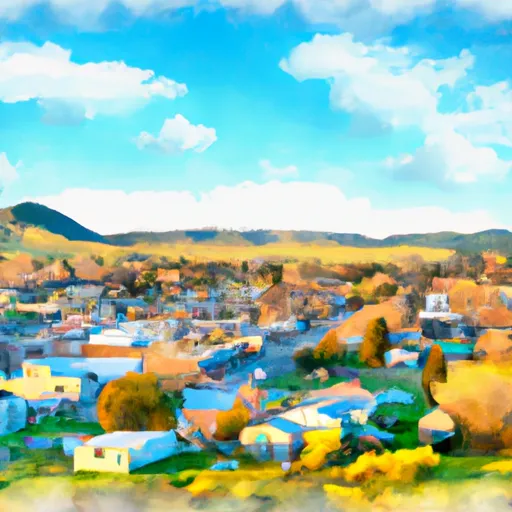-
 Snoflo Premium
Snoflo Premium
Get unlimited access to all our content
With no Ad interruptions! - Start Your Free Trial Login with existing account
Warmsprings
Eden Index
Climate
6.4
•
Recreation
2.8
•
Community
•
Safeguard
3.6/10

Warmsprings, Montana is a small town located in Deer Lodge County. The town experiences a temperate climate, characterized by warm summers and cold winters. Summers are pleasant, with average temperatures ranging from the mid-70s to low 80s Fahrenheit, while winters can be chilly, with temperatures often dropping below freezing. Snowfall is common during the winter months, contributing to the town's picturesque landscape.
Warmsprings is blessed with abundant hydrology constituents. The town is situated near the Boulder River, which offers excellent fishing opportunities for anglers. The river is known for its healthy population of rainbow and brown trout, making it a popular spot for fly fishing enthusiasts. Additionally, the nearby Clark Fork River provides opportunities for river rafting, kayaking, and canoeing.
Outdoor recreation opportunities abound in Warmsprings. The surrounding area is ideal for hiking and camping, with numerous trails and campgrounds to explore. Adventurers can also enjoy wildlife watching, birding, and hunting in the region's diverse natural habitats. With its stunning landscapes and access to outdoor activities, Warmsprings, Montana is a hidden gem for nature lovers and outdoor enthusiasts alike.
What is the Eden Index?
The Snoflo Eden Index serves as a comprehensive rating system for regions, evaluating their desirability through a holistic assessment of climate health, outdoor recreation opportunities, and natural disaster risk, acknowledging the profound impact of these factors on livability and well-being.
Climate Health Indicator (CHI): 6.4
Warmsprings receives approximately
290mm of rain per year,
with humidity levels near 67%
and air temperatures averaging around
6°C.
Warmsprings has a plant hardyness factor of
4, meaning
plants and agriculture in this region thrive during a short period during spring and early summer. Most
plants will die off during the colder winter months.
By considering the ideal temperature range, reliable water supplies, clean air, and stable seasonal rain or snowpacks, the Climate Health Indicator (CHI) underscores the significance of a healthy climate as the foundation for quality living.
A healthy climate is paramount for ensuring a high quality of life and livability in a region, fostering both physical well-being and environmental harmony. This can be characterized by ideal temperatures, reliable access to water supplies, clean air, and consistent seasonal rain or snowpacks.
Weather Forecast
Streamflow Conditions
Pend Oreille
Area Rivers
Pend Oreille
Snowpack Depths
Pend Oreille
Reservoir Storage Capacity
Pend Oreille
Groundwater Levels
Recreational Opportunity Index (ROI): 2.8
The Recreational Opportunity Index (ROI) recognizes the value of outdoor recreational options, such as parks, hiking trails, camping sites, and fishing spots, while acknowledging that climate plays a pivotal role in ensuring the comfort and consistency of these experiences.
Access to outdoor recreational opportunities, encompassing activities such as parks, hiking, camping, and fishing, is crucial for overall well-being, and the climate plays a pivotal role in enabling and enhancing these experiences, ensuring that individuals can engage in nature-based activities comfortably and consistently.
Camping Areas
| Campground | Campsites | Reservations | Toilets | Showers | Elevation |
|---|---|---|---|---|---|
| Beaverdam | 15 | 6,496 ft | |||
| Greenwood Bottoms FAS | None | 5,484 ft | |||
| Maidenrock FAS | 10 | 5,206 ft | |||
| Orofino | 10 | 6,446 ft | |||
| Racetrack | 12 | 5,376 ft | |||
| Divide Bridge | 25 | 5,413 ft |
Nearby Ski Areas
Catastrophe Safeguard Index (CSI):
The Catastrophe Safeguard Index (CSI) recognizes that natural disaster risk, encompassing floods, fires, hurricanes, and tornadoes, can drastically affect safety and the overall appeal of an area.
The level of natural disaster risk in a region significantly affects safety and the overall livability, with climate change amplifying these risks by potentially increasing the frequency and intensity of events like floods, fires, hurricanes, and tornadoes, thereby posing substantial challenges to community resilience and well-being.
Community Resilience Indicator (CRI):
The Community Resilience Indicator (CRI) recognizes that education, healthcare, and socioeconomics are crucial to the well-being of a region. The CRI acknowledges the profound impact of these elements on residents' overall quality of life. By evaluating educational resources, healthcare accessibility, and economic inclusivity, the index captures the essential aspects that contribute to a thriving community, fostering resident satisfaction, equity, and social cohesion.

